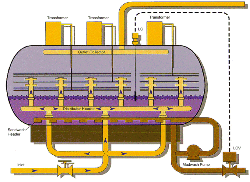简介:Cameron公司油气处理技术部最近成立新的技术中心,该中心位于休斯顿西北,旨在对现实生产中遇到的情况进行评估优化和处理。该中心的实验设备包括油气处理设备(HTU),波动模拟平台,加工模拟与测试循环系统,固体分离测试循环系统等。

The Process Systems division of Cameron recently opened the doors to its Technology Center, a sprawling complex in northwest Houston designed to evaluate, and optimize, processing scenarios encountered in real-world production.
Cameron Process Systems was formed by combining the complimentary business offerings of Petreco and Natco, which Cameron acquired last year. The new test facility houses many of Natco's proven testing equipment from its former Tulsa location.
Some of the facility's testing capabilities include:
Hydrocarbon Treatment Unit (HTU)
The facility houses two HTU batch-through flow testing units to simulate crude-oil electrostatic dehydration and desalting processes, customizable to nearly any customer condition. The HTUs can run up to 8 pieces of testing equipment, which Cameron says is unique to the industry. Testing capabilities include dehydration and desalting (1-3 stages), comparative studies among different electrostatic technologies on a single unit and a scaled 1:1 treating section for accurate field simulation. Typical test durations range from 1 to 6 weeks.
The HTUs can evaluate field crudes from 11 42 degrees
API, and are rated for pressures up to 265 psi and temperatures up to 350°F.
Customers are welcome to observe tests of their crudes in person, which allows any necessary changes to a test protocol to be made quickly and with their input. This in-person testing also allows a customer to learn more about their crude and what potential challenges they may face during separation and desalting operations in the field, Cameron states.
Wave Motion Simulation Platform
Driven by computer-controlled hydraulic cylinders, the Technology Center's wave platform simulates the wave motions that affect equipment such as floating production, storage, and offloading vessels; tankers; and separators to allow for modification and optimization of internals, gates, and baffles. The platform simulates the six degrees of freedom that ocean vessels experience, and facilitates the investigation of system resonance, fluid forces, structural integrity, and process influences for sea conditions at varying storm levels.
Process Simulation and Test Loop (PSAT)
The PSAT, a closed-loop evaluation-and-optimization flow system, can simulate a variety of gas or crude-oil process systems, including a 2- or 3-phase feed stream in a production plant or a process feed in a petrochemical plant. It can also be used for process technology prototype development.
To that end, the PSAT is currently being used to test and develop a compact separation unit intended to replace a topsides free-water knock-out with a seafloor system that reinjects all separated water. The unit, which is still in the pilot stage, will be designed for 7,500 10,000 B/D throughput and is on track for field testing by research partner Petrobras in late 2010.
Solids Separation Test Loop (SST)
The facility's SST simulates oily solids removal from produced fluids and removal of surface and interstitial oil to produce oil-free solids. The system is designed to support the sizing, design, and operation of a full-scale solids-removal and cleaning package for actual field applications, Cameron states. The system is compact and simple in design, requires no chemicals, and does not generate a waste stream.
For more information, visit Cameron's Process Systems website.
[
复制 收藏
]
